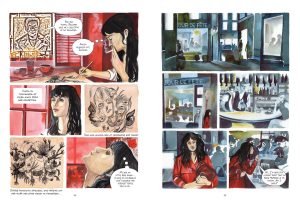Review by Karl Verhoven
When Unica Zürn died in 1970 she’d been afflicted with mental illness for a decade, but since her death respect for her writing and especially her importance as a visual artist has steadily grown. Unfortunately, though, anyone not already aware of who she is needs to be familiar with the basics as Betrayal of the Mind is very true to the later years of its subject, beginning with an uncomfortable internalisation. It’s fragmented and deliberately disorienting, effectively presenting a state of mind at the possible cost of alienating anyone who doesn’t immediately recognise what’s being portrayed.
That’s a shame because read further and it’s obvious Céline Wagner is taking risks in her portrayal in order to prioritise honesty. This isn’t a biography concerned with achievement and success, but one attempting to convey Zürn’s feelings and experiences. She led an uncomfortable, uncertain and unconventional life, convinced of delusions and capable of spontaneous life-altering decisions, and Wagner’s intention is to immerse readers beyond their comfort zone. Her illustration owes more to representational fine art for the most part, although often with outré subject matter true to the subtitle of The Surreal Life of Unica Zürn. There are leaps into cubism to accommodate Zürn’s partner Hans Bellmer, while the wildness of Zürn’s automatic drawings are also present, each a vision of delirium. Wagner frequently has Zürn stand out as she would have done in reality, a novel visual allegory having her isolated in red against a monotone blue world.
Wagner would have readers piece together a biography as if working out one of Zürn’s anagrammatic poems. The staging posts are all there, if occasionally referenced when dealing with another subject altogether, most prominently the rape aged nine that left a part of her forever a child seeking help and comfort. The traumas of confinement in an asylum are well explored, although strangely one of the most straightforward sequences in the book. That’s not to say it avoids slotting into the deeply unsettling nature Betrayal of the Mind establishes from the beginning with the constant accompaniment of Zürn’s disturbingly self-loathing poems.
“Kill Her!
Break her armpits
Drunk, she spins
Come in, see, strike!
Be as little as she
Nothing”
This isn’t easy reading. Zürn’s life is diminished, one beset by tragedy, and Betrayal of the Mind twists the noose via a nightmare narrative. In doing so, Wagner admits in her afterword that in places a literal interpretation is supplanted by an impressionistic one, but that’s in keeping with a route where commercial priority is secondary to thematic honesty.







